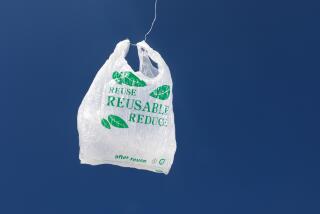Needed: A Disposable/Cloth Diaper Hybrid
- Share via
Diapering babies used to be a simple matter. Everybody did it, and what they did it with was their business.
Nothing’s simple any more. One’s choice of diapers is now everyone’s concern, even their cause. Disposable diapers are heavily criticized by many environmentalists; others say washable cloth diapers aren’t so great either. And the poor consumer may opt, guiltily, for convenience, price or health, waiting for some manufacturer to make a product that offers righteousness as well. Like many consumer products, disposable diapers--America’s preference 85% of the time--stand accused of ruining the environment, which cannot handle the 16 billion to 18 billion diapers tossed annually into the nation’s landfills to sit for 500 years.
State and local lawmakers want disposables banned or forced to bear warning labels. Entrepreneurs are pushing “biodegradable” disposables or specially catalogued cotton diapers (“reusables,” in today’s parlance) at almost double the regular retail price. Manufacturers of disposables insist that they’re not bad for the land, could be good for the land and are certainly better for the land than washables.
Unfortunately, disposable diapers aren’t like hair spray, or even detergent--easily given up or replaced by similar substances. They’re so useful, so convenient, so appropriate for today’s parents, that they even seem worth some environmental ruin. The mere threat of ruin isn’t persuasive enough. “With all the environmental stuff you hear these days,” says one mother, “you don’t really know if it’s a crisis or not a crisis.”
Even the environmental experts aren’t sure. Some are horrified that a single consumer product represents 2% of our landfill, although that’s a lot less than newspapers and magazines or yard waste. They may add that disposables also use up raw materials and contribute to water pollution, releasing contaminants in the manufacturing process.
The Sierra Club, for one, has backed proposals to put warning labels on disposables and require day-care centers to use cloth diapers. The Environmental Defense Fund has taken no formal stand, but staff scientist Jackie Prince says, “At this point, the cloth diaper system is overall more environmentally sound.”
But washable cloth diapers aren’t that clean, environmentally. They use up both heat and water. If everyone switched to cloth, another 57 billion gallons of water would go down the drain annually, says Procter & Gamble, whose brilliant marketing of Pampers two decades ago switched so many away from cloth. Washing diapers releases even more contaminants--both waste products and detergents--and more “process” solid waste (sludge and ash). And diaper services use gas and pollute the air driving their trucks around.
The Natural Resources Defense Council finds, therefore, that cloth diapers only “come out somewhat ahead,” according to senior staff scientist Allen Hershkowitz. In a study recently done for P&G;, Arthur D. Little found “neither disposable nor reusable diapers . . . clearly superior” in environmental terms. “You’re comparing apples to oranges, weighing water use and air pollutants on one side against solid wastes on the other,” says Stow Walker, an environmental consultant for Cambridge, Mass.-based ADL.
There are other considerations that make many environmentally aware people unusually pro-choice when it comes to diapers. Cloth advocates are often swayed most by price, because home-washed diapers, and even diaper services, are less expensive than disposables. Most disposable users mention convenience. Some cite health concerns, ranging from fear of diaper rashes to the thought of dirty cloth diapers piling up at day-care centers.
No wonder Hershkowitz, a professional environmentalist, has said that the choice “has to be a personal one.” His two children wore disposables.
Meantime, the business world is trying to make the choice easier. A resurgence of diaper services, which were almost extinct, makes cloth diapers more attractive and convenient.
“Biodegradable” versions of disposables were introduced, featuring plastic liners partly made from cornstarch, so they’d break down in sunlight. Unfortunately, neither diapers nor other such “biodegradables” get much sun while embedded in landfills.
Procter & Gamble wants to help too. After all, it has half the $3.5-billion U.S. disposable market--a fair piece of change--and even more abroad.
But it offers the consumer nothing new and leaves a lot to other industries. It’s supporting recycling experiments that turn its plastic diaper liners into flower pots and garbage bags and their padding into boxes and building insulation. If that doesn’t catch on, it’s also investing $20 million in encouraging communities to build municipal composting plants to turn solid waste, including diapers, into useful humus.
Any consumer who can find something in this mess that’s both personally convenient and ideologically satisfying is way ahead. Many say they won’t give up disposables, but feel defensive or guilty about it--a good indication that they’d welcome a product that made them feel good besides.
Given such loyalty, the response, or non-response, of the big disposable manufacturers seems surprising, though they apparently hear the message. Someone could seize the whole market and a lot of cloth users besides if he or she came up with a totally new product--”a better system,” says Jackie Prince at the Environmental Defense Fund, “that combines the advantages of each but (is) more environmentally sound.”
Where is the brilliance of a Pampers now that it’s needed again?
More to Read
Inside the business of entertainment
The Wide Shot brings you news, analysis and insights on everything from streaming wars to production — and what it all means for the future.
You may occasionally receive promotional content from the Los Angeles Times.










